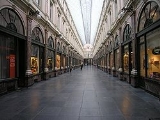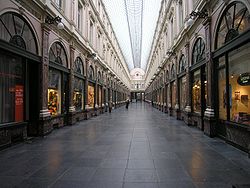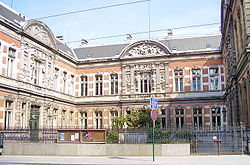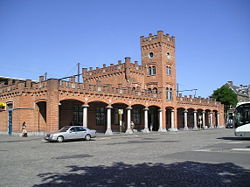
Jean-Pierre Cluysenaer
Encyclopedia

Belgium
Belgium , officially the Kingdom of Belgium, is a federal state in Western Europe. It is a founding member of the European Union and hosts the EU's headquarters, and those of several other major international organisations such as NATO.Belgium is also a member of, or affiliated to, many...
architect. He was born in Kampen
Kampen (Overijssel)
Kampen is a municipality, a city and an old Hanseatic city at the lower reaches of the river IJssel in the Dutch province of Overijssel.The municipality of Kampen counts 50,073 inhabitants in an area of approximately 162 km² . Kampen is located in the North West of Overijssel and is the...
in Holland as a descendant of a Dutch family of architects and engineers. During the United Kingdom of the Netherlands
United Kingdom of the Netherlands
United Kingdom of the Netherlands is the unofficial name used to refer to Kingdom of the Netherlands during the period after it was first created from part of the First French Empire and before the new kingdom of Belgium split out in 1830...
his family settled in the southern Belgian provinces. Cluysenaar studied architecture at the Académie Royale des Beaux-Arts
Académie Royale des Beaux-Arts
The Académie Royale des Beaux-Arts in Brussels is an art school, founded in 1711.The faculty and alumni of ARBA include some of the most famous names in Belgian painting, sculpture, and architecture: James Ensor, Rene Magritte, and Paul Delvaux...
in Brussels under Tilman-François Suys
Tilman-François Suys
Tilman-François Suys or Tieleman Frans Suys , was a Belgian architect who also worked in the Netherlands....
. His teacher influenced him in his preference for the architecture of the Italian Renaissance
Italian Renaissance
The Italian Renaissance began the opening phase of the Renaissance, a period of great cultural change and achievement in Europe that spanned the period from the end of the 13th century to about 1600, marking the transition between Medieval and Early Modern Europe...
.
Cluysenaar had a talent for business. He took the initiative for some very profitable real estate projects - such as the Galeries Royales Saint-Hubert
Galeries Royales Saint-Hubert
The Galeries Royales Saint-Hubert or Koninklijke Sint-Hubertusgalerijen is a glazed shopping arcade in Brussels that preceded other famous 19th-century shopping arcades such as the Galleria Vittorio Emanuele II in Milan and The Passage in St Petersburg...
in Brussels
Brussels
Brussels , officially the Brussels Region or Brussels-Capital Region , is the capital of Belgium and the de facto capital of the European Union...
- in which he played the double role of architect and co-financier.
He also had a good reputation amongst the Belgian nobility
Belgian nobility
In the Kingdom of Belgium there are at the moment approximately 1,300 noble families. Some 20,000 individuals are titled. The noble lineage of only ca. 400 families dates back to the 17th century. As Belgium is a democratic constitutional monarchy there are no legal privileges attached to bearing a...
and high bourgeoisie. He received many commissions for designing large town houses (so called "Hôtels"), Mansions and château
Château
A château is a manor house or residence of the lord of the manor or a country house of nobility or gentry, with or without fortifications, originally—and still most frequently—in French-speaking regions...
's. He was always prepared to adapt his designs to the desires and taste of his elite patrons. The many private mansions he build greatly differ in style. Cluysenaer designed elegant Palladian villa's as well as more sturdy Gothic Revival castles.
His stylistic versatility is also apparent in the many public buildings he designed such as the Neo-Renaissance
Neo-Renaissance
Renaissance Revival is an all-encompassing designation that covers many 19th century architectural revival styles which were neither Grecian nor Gothic but which instead drew inspiration from a wide range of classicizing Italian modes...
, Koninklijk Conservatorium
Koninklijk Conservatorium (Brussels)
The Royal Conservatory of Brussels is a drama and music college in Brussels, Belgium. An academy for acting and the arts, it has been attended by many of the top actors and actresses in Belgium such as Josse De Pauw, Luk van Mello and Luk De Konink....
/Conservatoire Royal in Brussels
Brussels
Brussels , officially the Brussels Region or Brussels-Capital Region , is the capital of Belgium and the de facto capital of the European Union...
and the "Tudor style" railway station in Aalst
Aalst, Belgium
Aalst is a city and municipality on the Dender River, 19 miles northwest from Brussels. It is located in the Flemish province of East Flanders in the Denderstreek. The municipality comprises the city of Aalst itself and the villages of Baardegem, Erembodegem, Gijzegem, Herdersem, Hofstade,...
.
Jean-Pierre Cluysenaer was the father of the painter Alfred Cluysenaer.
He was also the grandfather of architect Paul Saintenoy
Paul Saintenoy
Paul Saintenoy was a Belgian architect, teacher, architectural historian, and writer.Born in Ixelles, in the Brussels-Capital Region, he was the son of an architect. He began studying architecture in Antwerp in 1881 then returned home to complete his training in Brussels...
who was a son of Cluysenaer's daughter Adèle and the architect Gustave Saintenoy.
List of works


"Châteaux" and other private residences
- "Hôtel" of baron Brugmann, rue d’Arenberg, Brussels (1844)
- "Hôtel Nagelmackers", LiègeLiègeLiège is a major city and municipality of Belgium located in the province of Liège, of which it is the economic capital, in Wallonia, the French-speaking region of Belgium....
(1846) - ChâteauChâteauA château is a manor house or residence of the lord of the manor or a country house of nobility or gentry, with or without fortifications, originally—and still most frequently—in French-speaking regions...
"de Bavay", Vorst (1851) - ChâteauChâteauA château is a manor house or residence of the lord of the manor or a country house of nobility or gentry, with or without fortifications, originally—and still most frequently—in French-speaking regions...
Rey, today town hall of DrogenbosDrogenbosDrogenbos is a municipality located in the Belgian province of Flemish Brabant. The municipality only comprises the town of Drogenbos proper. On January 1, 2006 Drogenbos had a total population of 4,876. The total area is 2.49 km² which gives a population density of 1,957 inhabitants per...
(1852–1853) - ChâteauChâteauA château is a manor house or residence of the lord of the manor or a country house of nobility or gentry, with or without fortifications, originally—and still most frequently—in French-speaking regions...
of comte Ferdinand de Meeûs in Argenteuil near WaterlooWaterloo, BelgiumWaterloo is a Walloon municipality located in the province of Walloon Brabant, Belgium. On December 31, 2009, Waterloo had a total population of 29,573. The total area is 21.03 km² which gives a population density of 1,407 inhabitants per km²...
(1856–1858) - Hôtels de Meeûs, square Frère-Orban in BrusselsBrusselsBrussels , officially the Brussels Region or Brussels-Capital Region , is the capital of Belgium and the de facto capital of the European Union...
(1861) - ChâteauChâteauA château is a manor house or residence of the lord of the manor or a country house of nobility or gentry, with or without fortifications, originally—and still most frequently—in French-speaking regions...
of Baron de Viron, todat town hall of DilbeekDilbeekDilbeek is a municipality in the province of Flemish Brabant, in Flanders, one of the three regions of Belgium. The municipality comprises the villages of Dilbeek proper, Groot-Bijgaarden, Itterbeek , Schepdaal , Sint-Martens-Bodegem, and Sint-Ulriks-Kapelle...
(1862) - ChâteauChâteauA château is a manor house or residence of the lord of the manor or a country house of nobility or gentry, with or without fortifications, originally—and still most frequently—in French-speaking regions...
of Vieux-Sart, Corroy-le-Grand (1864) - Mansion of the violoncellist Adrien-François ServaisAdrien-Francois ServaisAdrien-François Servais was one of the most influential cellists of the nineteenth century. He was born and died in Halle, Belgium.Servais was originally trained as a violinist before switching to the cello...
in HalleHalle, BelgiumHalle , is a Belgian city and municipality in the district Halle-Vilvoorde of the province Flemish Brabant. The city is located on the Brussels-Charleroi Canal and on the Flemish side of the language border that separates Flanders and Wallonia...
(1859)
public buildings
- "Kiosque" in the park of Brussels (1840)
- Galeries Royales Saint-HubertGaleries Royales Saint-HubertThe Galeries Royales Saint-Hubert or Koninklijke Sint-Hubertusgalerijen is a glazed shopping arcade in Brussels that preceded other famous 19th-century shopping arcades such as the Galleria Vittorio Emanuele II in Milan and The Passage in St Petersburg...
,shopping arcade, Brussels (1845–1847) - Concert Hall in AachenAachenAachen has historically been a spa town in North Rhine-Westphalia, Germany. Aachen was a favoured residence of Charlemagne, and the place of coronation of the Kings of Germany. Geographically, Aachen is the westernmost town of Germany, located along its borders with Belgium and the Netherlands, ...
, GermanyGermanyGermany , officially the Federal Republic of Germany , is a federal parliamentary republic in Europe. The country consists of 16 states while the capital and largest city is Berlin. Germany covers an area of 357,021 km2 and has a largely temperate seasonal climate...
(1846) - "Panorama de la rue Royale" stairs and terraces surrounding the Congress ColumnCongress ColumnThe Congress Column is a monument situated on the Place du Congrès / Congresplein in Brussels. It commemorates the formation of the Belgian state and constitution by the National Congress in 1830-1831. It was erected on the initiative of Charles Rogier after a design by Joseph Poelaert between...
, Brussels, 1847 (demolished) - Marché de la Madeleine (Magdalenamarkt) covered market, Brussels (1847) (partly demolished)
- Galerie Borthier, shopping arcade, Brussels (1848)
- Railway stations for the "Société Dendre et Waes" in: TernatTernatTernat is a municipality located in the Belgian province of Flemish Brabant. The municipality comprises the villages of Sint-Katherina-Lombeek, Ternat proper and Wambeek. On January 1, 2006 Ternat had a total population of 14,625. The total area is 24.48 km² which gives a population density of 597...
(1856), AalstAalst, BelgiumAalst is a city and municipality on the Dender River, 19 miles northwest from Brussels. It is located in the Flemish province of East Flanders in the Denderstreek. The municipality comprises the city of Aalst itself and the villages of Baardegem, Erembodegem, Gijzegem, Herdersem, Hofstade,...
(1856), Zandbergen (1860). - "Hôpital des Aveugles", (home for blind people), Porte de Hal/Hallepoort, Brussels (1852).
- "Église de fer" (iron church) in Argenteuil (WaterlooWaterloo, BelgiumWaterloo is a Walloon municipality located in the province of Walloon Brabant, Belgium. On December 31, 2009, Waterloo had a total population of 29,573. The total area is 21.03 km² which gives a population density of 1,407 inhabitants per km²...
)(1855–1862). - Theatre and "Kurhaus" in Bad HomburgBad HomburgBad Homburg vor der Höhe is the district town of the Hochtaunuskreis, Hesse, Germany, on the southern slope of the Taunus, bordering among others Frankfurt am Main and Oberursel...
(1851, 1862–1866) - Royal Conservatory of BrusselsRoyal Conservatory of BrusselsThe Royal Conservatory of Brussels is a drama and music college in Brussels, Belgium. An academy for acting and the arts, it has been attended by many of the top actors and actresses in Belgium such as Josse De Pauw, Luk van Mello and Luk De Konink....
, rue de la Régence/Regentschapsstraat, BrusselsBrusselsBrussels , officially the Brussels Region or Brussels-Capital Region , is the capital of Belgium and the de facto capital of the European Union...
, (1872–1876)

